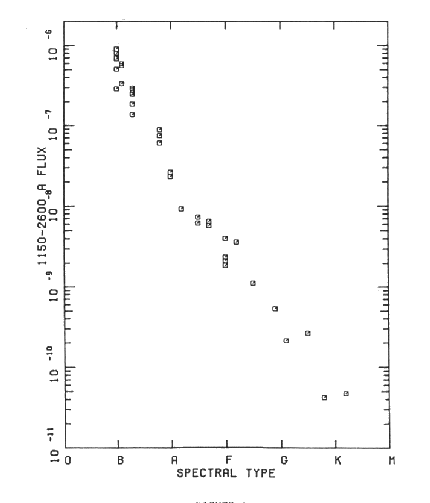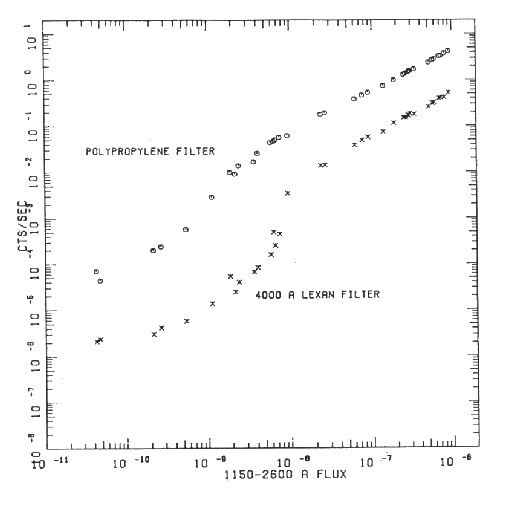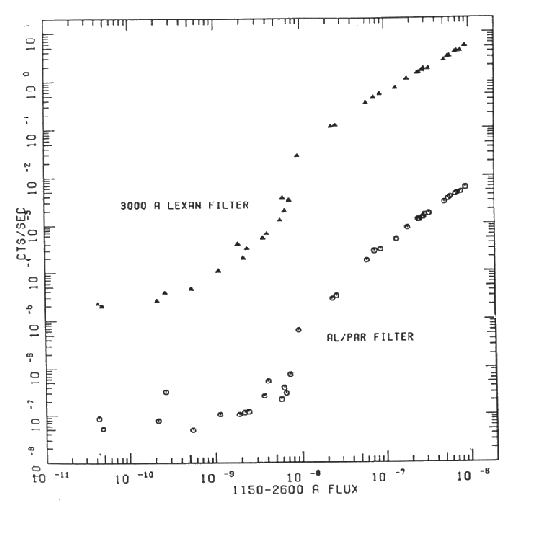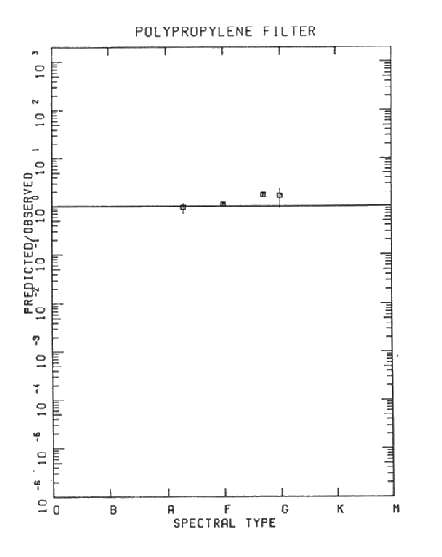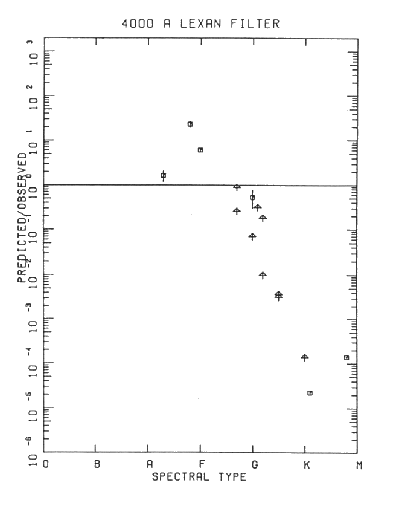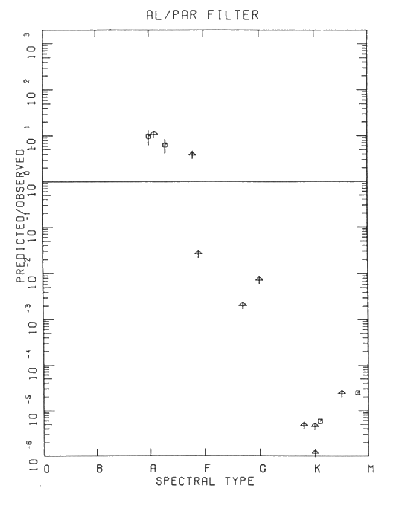EXOSAT UV CONTAMINATION - A PROGRESS REPORT1. IntroductionThese notes give an account of the current knowledge of the sensitivity of the EXOSAT CMA to ultraviolet radiation. Reference is made to section 8.1.4. of the EXOSAT Observers Guide (Part III - the Final Observation Tape Handbook). We recall here a basic summary of earlier work - theoretically, a UV effective area was computed from the filter transmission, CMA efficiency and optics area (including grid and flap). The CMA efficiency in the UV region as supplied by Leiden was normalised to the X-ray efficiency contained in the CCF. From the observational point of view the count rates of a number of UV sources (including a large number of AO sources) had been collected in a small data base, using the results of the automatic analysis. Both the theoretical area and the first observational results are reported in the FOTH. In principle the next step should have been a straight-forward comparison between observed and predicted count rates, i.e. taking the UV (IUE) spectrum of the object, convolving it through the theoretical effective area and comparing the number thus obtained with the observed value. This has not been possible, since for most of the objects in the EXOSAT sample no spectrum could be found in the IUE data bank (as an exception, for the brightest objects used as UV calibration targets one could find high dispersion spectra, which cannot be easily used for our purposes - see eg. Heck et al. 1984). A different approach had then to be taken, i.e. using "standard reference" spectra and normalizing them to the visual magnitude of the object in the EXOSAT sample of the same spectral type. Of course the appropriate correction for interstellar absorption has to be taken into account. The "simulated" spectra could then be convolved through the theoretical area. This procedure adds an extra uncertainty to the results, caused by the limitations of the spectral classification in the UV domain (see Heck et al. 1984). A description of the procedure, and of the current results is given below. We stress that this is a progress report and further information will be described as the work proceeds. 2. Selection of the Reference SampleThe sample containing the reference IUE spectra has been produced using the FITS tape containing the (ESA) IUE Low-Dispersion Atlas (Heck et al. 1984). This atlas comprises 229 objects, mainly of early spectral types. A small data base containing the magnitudes and spectral classification of the objects has been created using the data given for the individual spectra. Information on the extinction has been derived using the table in the (NASA) IUE Ultraviolet Spectral Atlas (Wu et al 1983), a partially different sample. 3. Production of the Reference Sample and of the EXOSAT SampleThe resulting reference sample consists therefore of the intersection of the two catalogues, a total of 65 objects with known E(B-V). The EXOSAT sample comprises all UV targets observed by EXOSAT, for which automatic analysis results were available. All objects later than the K spectral type have been discarded (apart from one, for which the UV spectrum was available). The magnitude and spectral classification have been derived from the Bright Star Catalogue. Since objects observed in Guest Observer programs are included in the sample, only statistical information is given here. The sample comprises 28 objects, distributed among the spectral types as indicated in the table below. A subset of the reference sample described above has been used, consisting of the stars of the same spectral type as the targets in the EXOSAT sample. This contains 35 objects and is referred to in the remainder of this paper. The A5 stars, for which no EXOSAT target exists, have been introduced into the sample in order to produce some prediction in a region where the UV component of the spectrum is rapidly changing with spectral type (they are used in Fig. 1and 2 only). It should be noted that all objects in the reference sample with the same spectral type as one object in the EXOSAT sample have been included (irrespective of the luminosity class). Therefore for some spectral types there are up to 6 reference objects, while for other types just one. The problems related to this are briefly discussed in the next section. A breakdown indicating the coverage of different spectral types is given below:
Three objects in the EXOSAT sample appear also in the reference sample (i.e. we have the IUE spectrum of the EXOSAT target): they are the one F, one G and one K star. EXOSAT data exist for at least two other objects in the reference sample, but they are as yet not available in the automatic analysis result data base. 4. Normalisation of the Reference SampleThe following procedure has been adopted to produce the standard reference spectra. Spectra and magnitudes in the reference sample have been de-reddened using the extinction law given by Seaton (1979). The reference spectra are then transformed into "simulated" spectra of the EXOSAT target under examination in two steps: first they are reddened using the E(B-V) of the EXOSAT target, then they are scaled to the appropriate V magnitude. At this stage they can be convolved with the theoretical area. This procedure has been applied to all objects in the EXOSAT sample for all reference objects of the same spectral type. As a guideline, all the reference spectra, normalized at V=6.0 and E(B-V)=0.0, have been convolved through the theoretical UV effective area. Note that sometimes a non-negligible scatter exists in the UV flux of objects with the same class and magnitude. This could be due to uncertainties in the spectral classification (we noted that sometimes the same object has different classifications in the different sources we used), and/or to the neglect of possible luminosity effects. An indication of this scatter is given in Fig.1, where the UV flux in the 1150-2600 Å range is plotted against the spectral class for the objects in the reference sample (normalised to V= 6.0 and no absorption). The wavelength range has been defined on the short wavelength side by the limit of the IUE range as used in the Atlas, and on the long wavelength side by the range in which the UV effective area is defined (see FOTH). Predicted EXOSAT count rates have been produced for the different filters for the normalised reference sample. These could serve as a guideline to estimate the UV contamination and are shown in Figs. 2a and 2b where the predicted count rates;are plotted versus the 1150-2600 Å flux (a fair indicator of the spectral type). Note, as expected, that the UV contamination is negligible for stars of spectral types later than or equal to F, and that the contribution in filter 6 (Al-Par) is negligible, in filter 3 (thick Lexan) quite low, in filters 7 and 2 (thin Lexan and Polypropylene) quite high. For early-type stars the prediction indicates a similar contribution in the latter two filters. A word of warning is however necessary, since shortwards of 1500 Å the Polypropylene transmission is not available and has been assumed to be zero, consistent with the sharp edge in our data possibly a drastic assumption. As a further caveat, note that no attempt has been made to estimate the contribution in the EUV region between 900 Å and 0.02 keV, where there is no data on filter transmissions (because of the edges in the PPL and Lexan filters a meaningful interpolation between existing UV and X-ray data is not possible). 5. Comparison between prediction and observationsThe predicted count rates based on the "simulated" spectra produced according to the procedure described above have been inserted into the data base containing the observed count rates and the other information relevant to the EXOSAT sample. Where more than one reference spectrum existed, the mean has been assumed (and the deviation from the mean as associated uncertainty). The results are shown in Figs. 3(a) to 3(d); one should be aware of the fact that some of the EXOSAT detections plotted are more properly upper limits (whenever the observed value was less than one sigma, the one sigma value is plotted instead). Please note that the sample for different filters is different, i.e. some of the objects in the EXOSAT sample have not been observed in all filters, and that:
The larger effect, i.e. the excess of counts in the late type objects can be explained in a simple way by selection effects. These objects are taken from the Guest Observer program, not from a UV calibration program, therefore they are likely to show coronal emission in the X-ray domain. This can be confirmed by the examination of the few objects for which IUE spectra exist. Excluding one for which there is only a marginal detection in thick Lexan, we note that the other two are obviously X-ray sources since they have been clearly detected in the Boron filter, and the discrepancy between prediction and observation is larger in the Al-Par filter (i.e. the least transparent to UV). A similar explanation holds also for the majority of the other late type objects. In three cases there is a detection in Boron (also in the case where more than one filter was used) and the discrepancy is always larger in the filter which is less transparent to UV . No obvious explanation exists at a first glance for the opposite effect, i.e. the apparent deficit in the early type objects. Note here that the predictions are based on the value of the theoretical effective area (i.e. as given in the FOTH), without any sum signal dependent efficiency correction. It is however known (see FOTH Section 8.1.3.4) that this effect could be quite large for UV sources (on the other hand the correction factor would be subject to large uncertainties, since fitting would be to the tail of the Pearson distribution) . Note finally that the apparent agreement obtained for the PPL filter may be affected by the poor knowledge of the PPL area shortwards of 1500 Å, as noted in Section 4. The observed ratio of count rates between two filters (since the most widely used filter is thin Lexan, i.e. FW7, the ratios FW7 over FW3, FW7 over FW6 and FW7 over FW2 have been used) have been compared with the predictions. For early type stars the predicted ratio FW7 over FW6 and FW7 over FW3 is quite close to the observed value, while the disagreement is larger for late type stars (and larger for the FW7 over FW6 ratio than for the FW7 over FW3). This seems on one hand to confirm that a significant X-ray flux is seen from the late type objects, on the other hand to indicate that the relative transmissions of filters 3, 6 and 7 are consistent with the theoretical values. The ratio FW7 over FW2 shows a different behaviour: late A-F type objects give a good agreement between prediction and observation (with a slight overestimation of the count rate in FW7) while for B-early A objects the FW7 count rate appears clearly overestimated. Alternatively (and consistent with the impression from observational evidence that early type objects show up quite extensively in the PPL filter) one can attribute the effect to the fact that the PPL area is erroneously assumed to be zero below 1500 Å, where most of the UV flux from early type objects is concentrated. 6. ConclusionA possible explanation which needs confirmation by a re- examination of the theoretical values for the CMA efficiency and filter transmissions is presented below. The transmission of filters 7, 6 and 3 is probably correct, while the transmission of filter 2 is arbitrarily set to zero shortwards of 1500 Å, but could instead be non-zero. Alternatively, the channel plate efficiency could be overestimated: this overestimation reflects the fact that the effective area of the plate + filter is also overestimated for filters 7, 6 and 3, while the overestimation of the CMA efficiency and the underestimation in the PPL transmission cancel out each other (and the latter effect is of course visible for early stars which have a significant far UV flux). With the explanation,given above, one can use the areas given in the FOTH for a conservative estimate of the UV contamination when planning EXOSAT observations. However a more precise quantitative approach, in order to correct observed count rates for the UV contribution and perform an X-ray analysis, requires further work. RequestIn view of the remaining uncertainties in the quantum efficiency of the CMA and the mass absorption coefficients of the filter materials (especially PPL) we urgently request the scientific community for references or data on these topics. Please contact Ed Gronenschild or Paolo Giommi. L. Chiappetti IFCTR, Milan ReferencesChiappetti, L., 1984. EXOSAT Observers Guide (Part III), Section 8.1.4 (FOTH). Heck, A., Egret, D., Jaschek, M., and Jaschek, C. 1984. IUE Low-dispersion Spectra Reference Atlas - Part I. Normal Stars, ESA SP-1052. Hoffleit, D. 19?? Catalogue of Bright Stars. Seaton, M.J., 1979. M.N.R.A.S., 187, 73p. Wu, C.C., Ake, T.B., Boggess, A., Bohlin, R.C., Imhoff, C.L., Holm, A.V., Levay, Z.G., Panek, R.J., Schiffer, F.H., and Turnrose, B.E. 1983. The IUE Ultraviolet Spectral Atlas, NASA IUE Newsletter 22. Figure CaptionsFig. 1 Fig. 2(a) & 2(b) Fig. 3(a) - 3(d) |


